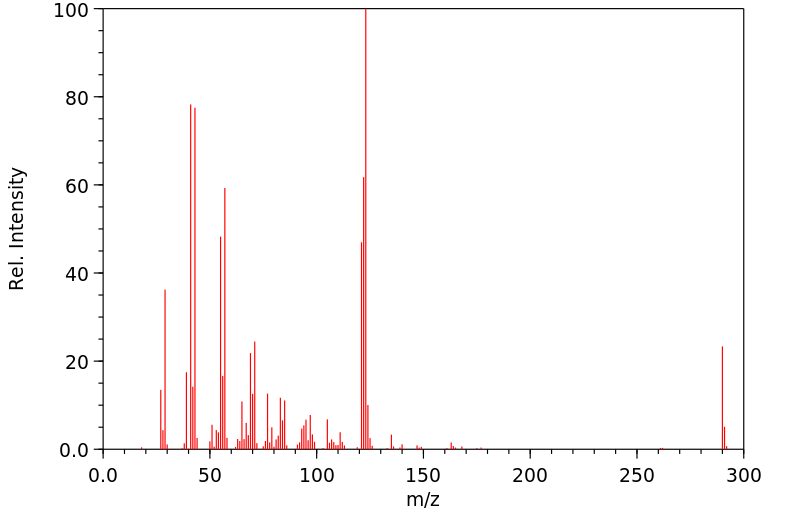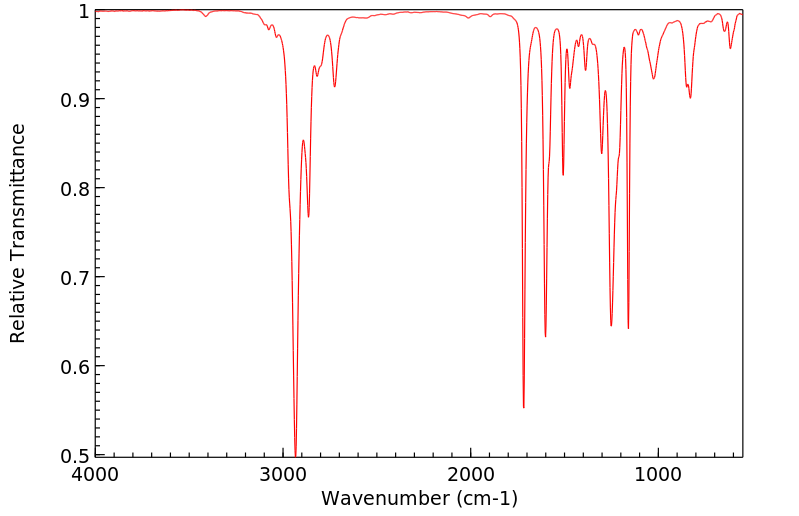4-正癸氧基苯甲醛 | 24083-19-0
中文名称
4-正癸氧基苯甲醛
中文别名
4-正十二烷基苯甲醛
英文名称
4-n-dodecyloxybenzaldehyde
英文别名
4-dodecyloxybenzaldehyde;p-dodecyloxybenzaldehyde;p-dodecoxybenzaldehyde;4-(Dodecyloxy)benzaldehyde;4-dodecoxybenzaldehyde
CAS
24083-19-0
化学式
C19H30O2
mdl
MFCD00043523
分子量
290.446
InChiKey
ZBEGLEYBWGNZJA-UHFFFAOYSA-N
BEILSTEIN
——
EINECS
——
-
物化性质
-
计算性质
-
ADMET
-
安全信息
-
SDS
-
制备方法与用途
-
上下游信息
-
文献信息
-
表征谱图
-
同类化合物
-
相关功能分类
-
相关结构分类
物化性质
-
熔点:25-28 °C
-
沸点:165°C 0mm
-
密度:0.9731 (rough estimate)
-
闪点:165°C/0.005mm
-
稳定性/保质期:
避免接触氧化物和空气。
计算性质
-
辛醇/水分配系数(LogP):7.1
-
重原子数:21
-
可旋转键数:13
-
环数:1.0
-
sp3杂化的碳原子比例:0.631
-
拓扑面积:26.3
-
氢给体数:0
-
氢受体数:2
安全信息
-
危险品标志:Xi
-
海关编码:2912499000
-
安全说明:S24/25
-
危险类别码:R36/37/38
-
储存条件:将其存放在紧密的容器中,并储存在阴凉、干燥的地方。
SDS
| Name: | 4-Dodecyloxybenzaldehyde 99% (GC) Material Safety Data Sheet |
| Synonym: | None known |
| CAS: | 24083-19-0 |
Synonym:None known
Section 2 - COMPOSITION, INFORMATION ON INGREDIENTS
| CAS# | Chemical Name | content | EINECS# |
| 24083-19-0 | 4-Dodecyloxybenzaldehyde | 99 | unlisted |
Risk Phrases: 36/37/38
Section 3 - HAZARDS IDENTIFICATION
EMERGENCY OVERVIEW
Irritating to eyes, respiratory system and skin.The toxicological properties of this material have not been fully investigated.
Potential Health Effects
Eye:
Causes eye irritation. May cause chemical conjunctivitis.
Skin:
Causes skin irritation.
Ingestion:
May cause gastrointestinal irritation with nausea, vomiting and diarrhea. The toxicological properties of this substance have not been fully investigated.
Inhalation:
Causes respiratory tract irritation. The toxicological properties of this substance have not been fully investigated. Can produce delayed pulmonary edema.
Chronic:
Effects may be delayed.
Section 4 - FIRST AID MEASURES
Eyes: Flush eyes with plenty of water for at least 15 minutes, occasionally lifting the upper and lower eyelids. Get medical aid.
Skin:
Get medical aid. Flush skin with plenty of water for at least 15 minutes while removing contaminated clothing and shoes. Wash clothing before reuse.
Ingestion:
Never give anything by mouth to an unconscious person. Get medical aid. Do NOT induce vomiting. If conscious and alert, rinse mouth and drink 2-4 cupfuls of milk or water.
Inhalation:
Remove from exposure and move to fresh air immediately. If not breathing, give artificial respiration. If breathing is difficult, give oxygen. Get medical aid. Do NOT use mouth-to-mouth resuscitation.
Notes to Physician:
Treat symptomatically and supportively.
Section 5 - FIRE FIGHTING MEASURES
General Information:
As in any fire, wear a self-contained breathing apparatus in pressure-demand, MSHA/NIOSH (approved or equivalent), and full protective gear. During a fire, irritating and highly toxic gases may be generated by thermal decomposition or combustion.
Extinguishing Media:
Use agent most appropriate to extinguish fire. Use water spray, dry chemical, carbon dioxide, or appropriate foam.
Section 6 - ACCIDENTAL RELEASE MEASURES
General Information: Use proper personal protective equipment as indicated in Section 8.
Spills/Leaks:
Clean up spills immediately, observing precautions in the Protective Equipment section. Sweep up, then place into a suitable container for disposal. Avoid generating dusty conditions. Provide ventilation.
Section 7 - HANDLING and STORAGE
Handling:
Wash thoroughly after handling. Remove contaminated clothing and wash before reuse. Use with adequate ventilation. Minimize dust generation and accumulation. Avoid contact with eyes, skin, and clothing. Keep container tightly closed. Avoid ingestion and inhalation.
Storage:
Store in a tightly closed container. Store in a cool, dry, well-ventilated area away from incompatible substances.
Section 8 - EXPOSURE CONTROLS, PERSONAL PROTECTION
Engineering Controls:
Facilities storing or utilizing this material should be equipped with an eyewash facility and a safety shower. Use adequate ventilation to keep airborne concentrations low.
Exposure Limits CAS# 24083-19-0: Personal Protective Equipment Eyes: Wear appropriate protective eyeglasses or chemical safety goggles as described by OSHA's eye and face protection regulations in 29 CFR 1910.133 or European Standard EN166.
Skin:
Wear appropriate protective gloves to prevent skin exposure.
Clothing:
Wear appropriate protective clothing to prevent skin exposure.
Respirators:
A respiratory protection program that meets OSHA's 29 CFR 1910.134 and ANSI Z88.2 requirements or European Standard EN 149 must be followed whenever workplace conditions warrant respirator use.
Section 9 - PHYSICAL AND CHEMICAL PROPERTIES
Physical State: Powder
Color: light beige to beige
Odor: None reported.
pH: Not available.
Vapor Pressure: Not available.
Viscosity: Not available.
Boiling Point: Not available.
Freezing/Melting Point: 26 - 28 deg C
Autoignition Temperature: Not applicable.
Flash Point: Not applicable.
Explosion Limits, lower: Not available.
Explosion Limits, upper: Not available.
Decomposition Temperature:
Solubility in water:
Specific Gravity/Density:
Molecular Formula: C19H30O2
Molecular Weight: 290.45
Section 10 - STABILITY AND REACTIVITY
Chemical Stability:
Stable at room temperature in closed containers under normal storage and handling conditions.
Conditions to Avoid:
Incompatible materials, dust generation, excess heat, strong oxidants.
Incompatibilities with Other Materials:
Oxidizing agents.
Hazardous Decomposition Products:
Carbon monoxide, irritating and toxic fumes and gases, carbon dioxide.
Hazardous Polymerization: Has not been reported.
Section 11 - TOXICOLOGICAL INFORMATION
RTECS#:
CAS# 24083-19-0 unlisted.
LD50/LC50:
Not available.
Carcinogenicity:
4-Dodecyloxybenzaldehyde - Not listed by ACGIH, IARC, or NTP.
Section 12 - ECOLOGICAL INFORMATION
Section 13 - DISPOSAL CONSIDERATIONS
Dispose of in a manner consistent with federal, state, and local regulations.
Section 14 - TRANSPORT INFORMATION
IATA
Not regulated as a hazardous material.
IMO
Not regulated as a hazardous material.
RID/ADR
Not regulated as a hazardous material.
Section 15 - REGULATORY INFORMATION
European/International Regulations
European Labeling in Accordance with EC Directives
Hazard Symbols: XI
Risk Phrases:
R 36/37/38 Irritating to eyes, respiratory system
and skin.
Safety Phrases:
S 24/25 Avoid contact with skin and eyes.
S 28A After contact with skin, wash immediately with
plenty of water.
S 37 Wear suitable gloves.
S 45 In case of accident or if you feel unwell, seek
medical advice immediately (show the label where
possible).
WGK (Water Danger/Protection)
CAS# 24083-19-0: No information available.
Canada
None of the chemicals in this product are listed on the DSL/NDSL list.
CAS# 24083-19-0 is not listed on Canada's Ingredient Disclosure List.
US FEDERAL
TSCA
CAS# 24083-19-0 is not listed on the TSCA inventory.
It is for research and development use only.
SECTION 16 - ADDITIONAL INFORMATION
N/A
上下游信息
-
上游原料
中文名称 英文名称 CAS号 化学式 分子量 —— p-(dodecyloxy)benzyl alcohol 61440-63-9 C19H32O2 292.462 十二烷氧基苯 dodecyloxybenzene 35021-68-2 C18H30O 262.436 —— 1-bromo-4-dodecyloxybenzene 123883-51-2 C18H29BrO 341.332 对羟基苯甲醛 4-hydroxy-benzaldehyde 123-08-0 C7H6O2 122.123 -
下游产品
中文名称 英文名称 CAS号 化学式 分子量 4-十二烷氧基苯甲酸 p-dodecyloxybenzoic acid 2312-15-4 C19H30O3 306.445 4-正十二烷基苯甲酰胺 4-(dodecyloxy)benzamide 179341-69-6 C19H31NO2 305.461 —— p-(dodecyloxy)benzyl alcohol 61440-63-9 C19H32O2 292.462 —— 1-dodecyloxy-4-vinylbenzene 585521-25-1 C20H32O 288.473 —— 4-(dodecyloxy)benzyl bromide 123436-89-5 C19H31BrO 355.359 1-(十二烷氧基)-4-乙炔基苯 1-(dodecyloxy)-4-ethynylbenzene 121051-42-1 C20H30O 286.458 —— 4-(2-(4-dodecyloxyphenyl)-(E)-1-ethenyl)-1-benzaldehyde 819077-27-5 C27H36O2 392.582 —— 4-(n-dodecyloxy)benzaldoxime 114040-44-7 C19H31NO2 305.461 —— 4-Dodecyloxycinnamaldehyde —— C21H32O2 316.484 —— 4-dodecyloxybenzaldehyde dimethyl acetal —— C21H36O3 336.515 4-十二烷氧基苯酚 4-dodecyloxyphenol 13037-87-1 C18H30O2 278.435 (4-甲酰基苯基)4-十二烷氧基苯甲酸酯 4-formylphenyl 4-(dodecyloxy)benzoate 56800-36-3 C26H34O4 410.554 —— 4-dodecyloxycinnamic acid 71931-24-3 C21H32O3 332.483 —— 4-dodecyloxycinnamoyl chloride 77251-83-3 C21H31ClO2 350.929 —— (E)-3-(4-Dodecyloxy-phenyl)-acryloyl chloride 77251-83-3 C21H31ClO2 350.929 —— 4-(2-(4-dodecyloxyphenyl)-(E)-1-ethenyl)-1-benzonitrile 607716-65-4 C27H35NO 389.581 —— (E,E)-4-[2-(4-{2-[4-(dodecyloxy)phenyl]vinyl}phenyl)vinyl]benzonitrile 1277138-47-2 C35H41NO 491.717 —— 4-formylphenyl 4-n-dodecyloxycinnamate 76622-48-5 C28H36O4 436.591 —— 5-[(E)-2-(4-Dodecyloxy-phenyl)-vinyl]-benzene-1,3-diol 190371-63-2 C26H36O3 396.57 —— 2-[4-(dodecyloxy)benzylamino]-2-(hydroxymethyl)propane-1,3-diol 1432018-47-7 C23H41NO4 395.583 —— (E)-4-Dodecyloxy-N-phenylbenzaldimin 148172-13-8 C25H35NO 365.559 —— α-(4-(dodecyloxy)phenyl)-N-tert-butylnitrone 80311-20-2 C23H39NO2 361.568 —— 4-(4-n-dodecyloxybenzylideneamino)phenol —— C25H35NO2 381.558 —— (E)-1-[4-(dodecyloxy)phenyl]-2-(3,5-dimethoxyphenyl)ethene 190371-56-3 C28H40O3 424.624 —— 4-[4-dodecyloxybenzylideneamino]benzoic acid 15086-44-9 C26H35NO3 409.569 - 1
- 2
- 3
反应信息
-
作为反应物:参考文献:名称:Lohar, J. M.; Mahsru, Urvashi, Indian Journal of Chemistry, Section A: Inorganic, Physical, Theoretical and Analytical, 1981, vol. 20, # 2, p. 125 - 128摘要:DOI:
-
作为产物:描述:参考文献:名称:杯[4]低聚亚苯基亚乙烯基:用于设计π共轭液晶衍生物的新型刚性核摘要:描述了一种新的共轭衍生物的合成和液晶性质,该共轭衍生物组装了由杯[4]芳烃核产生的四个低聚亚苯基亚乙烯基(OPV)部分。光物理研究还显示了杯[4] OPV衍生物的四个OPV片段之间的强电子耦合。DOI:10.1016/s0040-4039(01)00169-1
-
作为试剂:参考文献:名称:新型表面活性的介孔取代卟啉的合成摘要:DOI:10.1007/bf00472622
文献信息
-
The effect of position of <i>tert</i>-butyl tail group on the formation of liquid crystal in Schiff base ester based homologous series作者:V. S. Sharma、R. B. PatelDOI:10.1080/15421406.2017.1283886日期:2017.5.3ABSTRACT We report a newly rod like calamatic liquid crystalline materials, which are constructed by the self-organization of a rod-like carboxylic acid derivative based on Schiff base ester as the linking group with tert butyl tail group. A newly series of 4-(tert-butyl) phenyl 4-((4-alkoxybenzylidene) amino) benzoate with different alkyl chain spacer (n = 1 to 8, 10, 12, 14, 16, and 18) were synthesized
-
Synthesis of dinuclear complexes of rhenium(I) as potential metallomesogens作者:Marie-Andrée Guillevic、Mark E. Light、Simon J. Coles、Thomas Gelbrich、Michael B. Hursthouse、Duncan W. BruceDOI:10.1039/a910273f日期:——Seven anisotropic diimines and their corresponding dinuclear complexes of rhenium(I) have been synthesized. The crystal and molecular structures of one of the dimines and two of the complexes were determined. In common with related imine ligands which have been synthesized previously, the new diimines were mesomorphic showing smectic C and nematic phases and, in some cases, smectic I and crystal J phases. However, none of the orthometallated, dinuclear complexes showed any liquid crystal phases.
-
Biomimetic Generation and Remodeling of Phospholipid Membranes by Dynamic Imine Chemistry作者:Andrés Seoane、Roberto J. Brea、Alberto Fuertes、Kira A. Podolsky、Neal K. DevarajDOI:10.1021/jacs.8b04557日期:2018.7.11reaction of the natural amine-containing lysosphingomyelin with a series of long-chain aldehydes to form imines. This transformation results in the formation of phospholipid liposomes that are in dynamic equilibrium with the aldehyde-amine form. The reversibility of the imine linkage is exploited in the synthesis of vesicles that are capable of responding to external stimuli such as temperature or the
-
NANOPARTICLES AND NANOPARTICLE COMPOSITIONS申请人:Zhao Yan公开号:US20130101516A1公开(公告)日:2013-04-25The invention provides multivalent surface-crosslinked micelle (SCM) particles, crosslinked reverse micelle (CRM) particles, and methods of making and using them. The SCM particles can be used, for example, to inhibit a virus or bacteria from binding to a host cell. The inhibition can be used in therapy for the flu, cancer, or AIDS. The CRM particles can be used, for example, to prepare metal nanoparticles or metal alloy nanoparticles, or they can be used in catalytic reactions.
-
Highly frustrated liquid crystal phases in optically active dimers: synthesis and rich phase transitional behavior作者:Rashmi Ashwathama Nayak、Sachin A. Bhat、G. Shanker、D. S. Shankar Rao、C. V. YelamaggadDOI:10.1039/c8nj03520b日期:——vital role in deciding the phase sequences of the dimers. In general, the dimers possessing an even-parity spacer display enantiotropic LC phases such as chiral nematic (N*), twist grain boundary (TGB), smectic A (SmA), chiral smectic C (SmC*) and twist grain boundary phase with SmC* slabs (TGBC*). Some of these dimers display TGBC* over a wide temperature range. The dimers with an odd-parity (5-oxypentanoyl)在本文中,我们报道了四个新的旋光性,非对称二聚体系列的合成和表征,其中胆固醇通过ω-氧烷酰基间隔基与席夫碱核心共价连接。虽然席夫碱芯取代有Ñ -butyloxy,Ñ -己氧基,Ñ -octyloxy,Ñ -decyloxy和Ñ-十二烷基氧基尾巴,三个偶数奇偶性间隔基,即4-氧丁酰基,6-氧己酸基,8-氧辛酸酰基和奇数奇偶性间隔基,即5-氧戊酰基,已被用于连接两个核。实验结果表明,间隔基的长度和奇偶性以及末端尾部的长度在决定二聚体的相序方面起着至关重要的作用。通常,具有偶数奇偶性间隔基的二聚体显示对映LC相,例如手性向列相(N *),扭曲晶界(TGB),近晶A(SmA),手性近晶C(SmC *)和扭曲晶界相,其中SmC *平板(TGBC *)。这些二聚体中的一些在较宽的温度范围内显示TGBC *。带有奇数奇偶性(5-氧戊酰基)间隔基的二聚体,与其偶数对应的蓝相(BPIII / II / I)不同;此外,它们还可以稳定N
表征谱图
-
氢谱1HNMR
-
质谱MS
-
碳谱13CNMR
-
红外IR
-
拉曼Raman
-
峰位数据
-
峰位匹配
-
表征信息
同类化合物
(R)-3-(叔丁基)-4-(2,6-二异丙氧基苯基)-2,3-二氢苯并[d][1,3]氧杂磷杂环戊烯
(2S,3R)-3-(叔丁基)-2-(二叔丁基膦基)-4-甲氧基-2,3-二氢苯并[d][1,3]氧杂磷杂戊环
(2S,2''S,3S,3''S)-3,3''-二叔丁基-4,4''-二甲氧基-2,2'',3,3''-四氢-2,2''-联苯并[d][1,3]氧杂磷杂戊环
(2R,2''R,3R,3''R)-3,3''-二叔丁基-4,4''-二甲氧基-2,2'',3,3''-四氢-2,2''-联苯并[d][1,3]氧杂磷杂戊环
(2-氟-3-异丙氧基苯基)三氟硼酸钾
(+)-6,6'-{[(1R,3R)-1,3-二甲基-1,3基]双(氧)}双[4,8-双(叔丁基)-2,10-二甲氧基-丙二醇
麦角甾烷-6-酮,2,3,22,23-四羟基-,(2a,3a,5a,22S,23S)-
鲁前列醇
顺式6-(对甲氧基苯基)-5-己烯酸
顺式-铂戊脒碘化物
顺式-四氢-2-苯氧基-N,N,N-三甲基-2H-吡喃-3-铵碘化物
顺式-4-甲氧基苯基1-丙烯基醚
顺式-2,4,5-三甲氧基-1-丙烯基苯
顺式-1,3-二甲基-4-苯基-2-氮杂环丁酮
非那西丁杂质7
非那西丁杂质3
非那西丁杂质22
非那西丁杂质18
非那卡因
非布司他杂质37
非布司他杂质30
非布丙醇
雷诺嗪
阿达洛尔
阿达洛尔
阿莫噁酮
阿莫兰特
阿维西利
阿索卡诺
阿米维林
阿立酮
阿曲汀中间体3
阿普洛尔
阿普斯特杂质67
阿普斯特中间体
阿普斯特中间体
阿托西汀EP杂质A
阿托莫西汀杂质24
阿托莫西汀杂质10
阿托莫西汀EP杂质C
阿尼扎芬
阿利克仑中间体3
间苯胺氢氟乙酰氯
间苯二酚二缩水甘油醚
间苯二酚二异丙醇醚
间苯二酚二(2-羟乙基)醚
间苄氧基苯乙醇
间甲苯氧基乙酸肼
间甲苯氧基乙腈
间甲苯异氰酸酯








